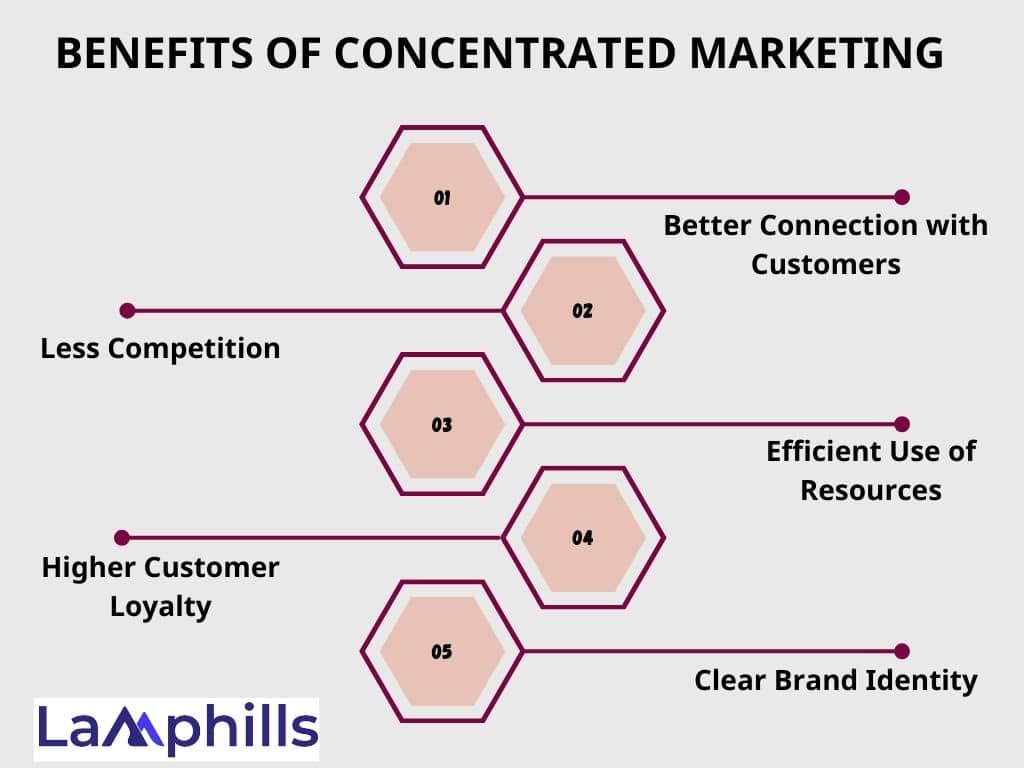Do you know what luxury brands like Gucci, Dior, Chanel, and the organic food market have in common? They both use a concentrated marketing strategy. This means they focus on selling to a specific group of people. This group can be based on age, gender, location, or income.
Imagine you’re in a busy marketplace, trying to get everyone to hear your message. But when you look around, you see that everyone else is doing the same thing. How can you stand out in all this noise?
The solution is concentrated marketing. Instead of trying to appeal to everyone, this approach focuses on a specific group, catering to their needs and preferences. By doing this, you can set your brand apart from the competition and become the top choice for your target audience.
Keep reading to learn more about concentrated marketing, its features, and benefits. We’ll also share real-life examples of companies using this strategy.
Key Points
- Concentrated marketing allows brands to target a specific group, like luxury brands do, ensuring that their messages resonate with their audience’s unique needs.
- By focusing on a smaller market, businesses can avoid the noise of mass marketing and establish themselves as leaders in their niche.
- Tailoring products and marketing to a specific audience fosters better connections, leading to increased customer loyalty and satisfaction.
- Concentrated marketing reduces competition, allowing businesses to dominate their niche and become the preferred choice for their target customers.
- Focusing on a specific market helps create a strong and recognizable brand identity, making it easier for customers to understand what the brand stands for.
Before we go on, let’s understand the main ways to target markets.
The Four Types of Market Targeting Strategies.
Understanding different market targeting strategies can help you see why certain approaches are used.
- Undifferentiated marketing, also called mass marketing, doesn’t focus on any specific group. It’s a strategy where a single message or product is created to attract as many people as possible. In this approach, everyone is seen as a potential customer. This works well for products with wide appeal, like basic food items or household cleaners.
- Differentiated marketing, also known as segmented marketing, focuses on different groups of customers. It tailors messages and products to meet the unique needs of each group, ensuring that each segment feels targeted and understood.
- Concentrated marketing, also called niche marketing, focuses on a specific part of the market by offering a specialized product or service. With this approach, you aim to attract a smaller, more focused group of customers.
- Micro marketing, also known as one-to-one marketing, goes even further. It tailors marketing messages and products to individual customers or very small groups. This method involves a lot of customization and is commonly used in areas like financial services or healthcare.
A few years ago, I decided to take a closer look at my marketing strategy. I put a lot of effort into my campaigns, yet my client’s brand wasn’t standing out as I had hoped. After some reflection, I realized I was spreading my efforts too thin, trying to appeal to too many people at once.
That’s when I shifted my focus to concentrated marketing, and it transformed the way my brand connected with its audience.
Now, what is concentrated marketing?
What Is Concentrated Marketing?
Concentrated marketing, also known as niche marketing, occurs when a business focuses all its efforts on one specific part of the market. Instead of trying to reach everyone, the company targets a small, well-defined group.
This allows businesses to customize their products and messages to meet the exact needs of this group. By doing this, they can increase customer satisfaction and build stronger loyalty.
Think of it as a tailor making clothes to fit each customer perfectly. Like a tailor takes measurements to ensure a great fit, businesses using concentrated marketing shape their products to match what their audience wants.
Just as a perfectly tailored suit can make someone feel confident and look their best, a well-planned concentrated marketing strategy can help a business stand out and attract loyal customers.
In simpler terms, concentrated marketing is like being a big fish in a small pond. You might not have the largest audience, but you can dominate your niche.
Before I started using concentrated marketing, I was trying to reach different audiences at the same time, thinking it would help me grow faster. But I soon realized I wasn’t making a strong connection with any of them.
When I decided to focus on just one group, young professionals in the tech industry, I began to see real progress. By addressing their specific needs, I could create personalized messages, which led to better engagement and stronger customer loyalty.
Concentrated Marketing vs. Differentiated Marketing
The main difference between concentrated and differentiated marketing is the market size you want to focus on. Concentrated marketing focuses on a small, specific part of the market, while differentiated marketing targets several different groups.
Another key difference is how much you need to customize your approach. With concentrated marketing, businesses need to carefully tailor their marketing to meet the unique needs of their target audience. Differentiated marketing also involves customization, but it’s done on a larger scale because businesses work with multiple groups.
Effective Concentrated Marketing Strategies
If you look closer, you’ll probably find some niches that are not being fully served. You can choose one of these niches and focus on dominating it. Studies show that companies that grow often use niche marketing more than others.
Here are some popular types of concentrated marketing strategies:
1. Local Marketing
This strategy focuses on a specific area or region. Businesses use it to meet the needs of a local community.
2. Demographic Marketing
Here, companies target customers based on factors like age, gender, income, or education level. For instance, a company might sell luxury items to high-income professionals or products aimed only at teenagers.
3. Product Specialization
Do you offer a limited range of specific products or services? A product specialization strategy could be a great choice! For instance, a company might focus on selling high-quality sports gear for a particular sport.
4. Price Specialization
Price specialization is another example of concentrated marketing. This strategy focuses on providing products or services at a specific price range. For example, a company might target budget-conscious shoppers by offering low-cost items.
Creating a successful concentrated marketing strategy doesn’t have to be complicated. To help you get started, we’ve compiled a simple template that walks you through the steps. Whether you’re just getting started or looking to refine your approach, this template will guide you in defining your audience, crafting the right message, and tracking your results. Download the template below to start focusing your marketing efforts on the right group of customers!
Now, it’s time to learn from the Experts. let’s look at examples of how these strategies work in real life.
Examples of Concentrated Marketing Strategies.
Here are some successful concentrated marketing examples to inspire and guide you.
#1. Pampers connects with a cause that matters to its audience.
Pampers, a well-known brand for babies and toddlers, started a heartwarming social media campaign called #ThankYouMidwife. The goal of the campaign was to show appreciation to midwives for their important role in helping bring babies into the world.
The campaign encouraged people to share their thank-you stories for midwives on social media using the hashtag #ThankYouMidwife. For every story shared, Pampers promised to donate £1 to the Royal College of Midwives Benevolent Fund.
The campaign was a big hit, with nearly 14,000 thank-you messages shared in the first week.
By supporting a cause that mattered to its audience, Pampers was able to boost brand awareness and loyalty while also giving back to society through donations.
#2. Warby Parker: Stylish Glasses at a Great Price
Warby Parker, a glasses company, took a different approach to marketing. They’ve changed the glasses industry by focusing on younger people who care about fashion and want affordable options. By selling trendy, budget-friendly glasses online, Warby Parker has become a popular choice compared to traditional brands.
#3. Lululemon: Selling athletic wear for fitness activities
Lululemon is a great example of concentrated marketing. This athletic brand has become a top choice for yoga fans and fitness enthusiasts, focusing on a specific group of health-conscious people. They have built a strong brand by offering stylish, high-quality workout gear that connects with their target audience.
Their products are made to be both functional and comfortable, using high-quality materials that withstand tough workouts.
Lululemon’s success shows the strength of niche marketing, proving that creating products that meet the needs of a specific group can lead to great success.
#4. Saddleback Leather: Focusing on Quality and Craftsmanship
Saddleback Leather is a small company based in Texas that creates high-quality leather products like bags, wallets, and accessories. Instead of attracting everyone, they focus on a specific group of customers: those who care more about quality and craftsmanship than low prices.
To reach this audience, Saddleback Leather highlights the durability and longevity of its products. It uses top-grade materials, and each item is handcrafted by skilled workers.
Their marketing focuses on the quality and attention to detail in their products. Because of this, they price their items higher to match their value.
By sticking to this niche market, Saddleback Leather has built a loyal group of customers who are happy to pay more for products that are built to last.
Now, let’s see the advantages of concentrated marketing.
What are the Benefits of Concentrated Marketing?

Concentrated marketing is a smart strategy that focuses on reaching a specific group of people instead of trying to appeal to everyone. By narrowing your target audience, you can connect with them better and grow your brand more effectively.
Here are five key benefits of using concentrated marketing:
#1. Better Connection with Customers
When you focus on a specific group of people, you can create messages that speak directly to their needs and interests. This helps build a stronger connection because your customers feel like you truly understand them.
#2. Less Competition
By targeting a niche market, you don’t have to compete with as many brands. Instead of trying to stand out in a crowded space, you can focus on a smaller group and become the go-to brand for them.
#3. Efficient Use of Resources
Concentrated marketing allows you to focus your time, money, and energy on a specific audience. This means you don’t waste resources trying to appeal to everyone, which can be expensive and time-consuming.
#4. Higher Customer Loyalty
When you tailor your products and marketing to a specific group, you’re more likely to create loyal customers. People appreciate brands that meet their needs well, and they’ll keep coming back for more.
#5. Clear Brand Identity
Focusing on a particular niche helps you develop a clear and strong brand identity. Customers will know exactly what your brand stands for and what they can expect from you, making it more recognizable and trustworthy.
In summary, concentrated marketing helps your brand stand out, build stronger connections, and use resources more efficiently. By focusing on a specific group, you can create loyal customers and develop a clear brand identity, making your business more successful in the long run.
Expert Tips to Dominate with Your Brand Using Concentrated Marketing
Concentrated marketing is about knowing who your ideal customers are and creating content, products, and services just for them. Over time, I’ve learned a few expert tips that helped me fine-tune my approach, and I’m sharing them here to help you dominate using your brand.
#1. Know Your Audience Inside and Out
Understanding your audience is the foundation of concentrated marketing. You need to know their needs, preferences, challenges, and interests. When I shifted my focus to young professionals in the tech industry,
I took the time to research their habits and desires. I learned they wanted stylish, affordable products matching their busy, modern lifestyle. This insight allowed me to tailor my marketing efforts specifically for them.
Take the time to gather detailed information about your audience. Use surveys, social media insights, and customer feedback to understand what makes them tick. The more you know, the better you can serve them.
#2. Craft a Clear Message
Once you know your audience, ensure your message speaks directly to them. When I was marketing to young professionals, I focused on how my products made their lives easier and fit their style.
It’s important to have a clear, simple message that shows why your brand is the best solution for your target audience’s problems. The clearer your message, the stronger the connection you’ll build with your customers.
#3. Choose the Right Channels
One of my most important lessons is that not all marketing channels work for every audience. My target audience spent most of their time on LinkedIn and Twitter, so I focused my marketing efforts there. This saved me time and energy while also boosting engagement.
Do your research to find out where your audience spends their time online. Whether it’s social media, email, or specific websites, focus your efforts on the channels where they are most active.
#4. Offer Tailored Content
People respond better to content that feels personal. I learned that engagement went up when I tailored my content to fit my audience’s interests and challenges.
Whether it’s blog posts, videos, or social media updates, make sure your content speaks directly to the needs and desires of your niche audience. Tailored content builds trust and helps your brand stand out.
#5. Measure and Adjust Regularly
Concentrated marketing allows you to see what’s working and what’s not. In my experience, regularly measuring the performance of my campaigns helped me make adjustments to improve results.
Use tools to track your audience’s engagement with your brand. If something isn’t working, don’t be afraid to change it. The more you adapt, the better your brand will perform.
If you follow these tips and stay consistent, you’ll be well on your way to growing a robust and loyal customer base.
Conclusion
Don’t let your business blend in with the rest. With niche marketing, you can confidently stand out and offer products and services that your customers will love.
By learning about your audience’s lifestyle, likes, and values, you can create products that truly connect with them. The best part? You won’t have to compete directly with big companies.
Concentrated marketing helps you find your space in the market and build a brand that people will be loyal to.
Answers to Frequently Asked Questions.
What are concentrated marketing examples?
A concentrated marketing approach focuses on one specific group or market. For example, a company might create a product just for teenage girls, or a shop might cater to people in the local area. One company that does this is Spacemode, which focuses on selling high-end watches.
What is the difference between concentrated marketing and niche marketing?
Concentrated marketing, also known as niche marketing, occurs when a company focuses on a small group of customers with a high potential for profit. With this approach, marketers need to understand the customers well to adjust their products, services, and prices to meet the group’s specific needs.
What is the opposite of concentrated marketing?
Undifferentiated marketing is quite different from a concentrated marketing strategy. Concentrated marketing focuses on just one specific group of customers. In contrast, undifferentiated marketing doesn’t target any particular group. Instead, it tries to reach a broad audience.
Why choose concentrated marketing?
Using less for marketing: Since focused marketing aims at reaching one specific group, companies often use fewer resources to promote their products or services. This can lead to reduced production and marketing expenses.
What are the advantages and disadvantages of concentrated marketing?
Concentrated marketing can be a good starting point for later marketing plans for a larger audience. However, it only targets a small group, which can make it hard for businesses to grow when needed.
Similar Articles
The Advantages and Disadvantages of Undifferentiated Marketing: A Comprehensive Overview
Proven SaaS Content Marketing Tactics for Boosting Engagement and Conversions
The Impact of Fragmented Media on Marketing: Challenges and Solutions






